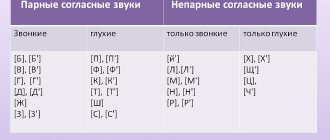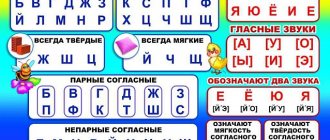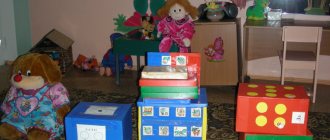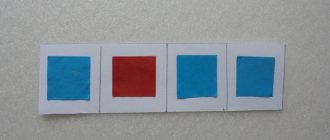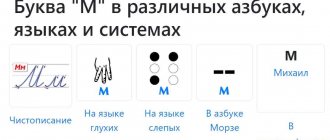How to teach children to distinguish between hard and soft consonants
The very first thing you need to teach your child: consonant sounds can be hard and soft, but not letters.
Typical mistake: Children confuse sounds and letters. We remember that a sound sounds, and a letter is an icon, it is written. A letter cannot be hard or soft; only a consonant sound can be hard or soft in pronunciation.
Sometimes children can easily learn to distinguish soft and hard sounds by ear. But it happens that this is difficult, and in this case signs will come to the rescue by which you can distinguish hard sounds from soft ones.
“Sound and letter “B”. Summary of a lesson on teaching literacy in the preparatory group
Mukhabat Batyrbaeva
“Sound and letter “B”. Summary of a lesson on teaching literacy in the preparatory group
Summary of a lesson on teaching children literacy in the preparatory group.
Topic: “Sound and letter “B”.
Goal: Improve the ability to distinguish sounds of the native language by ear and pronunciation. Practice diction: develop the ability to clearly and distinctly pronounce words with natural intonations.
Software tasks:
1. Continue to develop phonemic awareness, phonemic analysis and word synthesis.
2. Learn to isolate the sound “B” from the beginning of a word. Clarification of pronunciation and characteristics of the sound “B”.
3. Expand your vocabulary.
4. Develop memory, thinking, auditory and visual attention.
5. Continue to develop constructive skills by modeling letters from geometric shapes.
6. Develop tactile sensations.
7. Create a positive emotional background in the group.
GCD move:
Fairy tale "Mouse Tricks".
Educator: Guys, yesterday, when I was returning home from work, I met Pinocchio. He was terribly upset. I asked: “What happened?” He told me this story. He lived with his dad in a small town, on a quiet street, in a cozy wooden house. I learned to read and re-read all my books that lived on their bookshelf. On this shelf lived an old - old dictionary - a book where many words were collected and an explanation was given for them. But mice got into the habit of gnawing pages in the dictionary: every day, some word disappears, but its description remains. Gnawing on the dictionary, the mice hoped to learn to speak, but in vain. Almost all the words disappeared, but none of the mouse tribe spoke. Buratino really wanted to know everything, so he used the dictionary very often. What should he do now? Every word there is a hole there. Let's help Pinocchio restore some words from the description.
(I don’t say the words, but only their description.)
PAPER - it can be white, it can be colored, it can be thin, it can be velvet, they write and draw on it; Notebooks and books are made from it.
BEADS - they come in amber, pearl, glass; transparent and different colors. This is an ornament that is worn around the neck. It consists of many small and large parts.
AN ALARM CLOCK is a thing that is found in almost every home; it helps people not be late for work or kindergarten. With its help, people find out what time it is. This item itself can tell you: “It’s time to get up!”
BOUQUET - it is made up of individual flowers, it is placed in beautiful vases, it is given to artists, it is presented on a birthday.
(As I guess the words, I put pictures of these objects on a magnetic board.)
Well done boys! We coped with such a difficult task. Helped Pinocchio.
(Then I say the words again, emphasizing the first sound “B”.)
Guys, I’m looking and I just don’t understand how these words are similar? (Children's answers.)
That's right, all these words begin with the same sound "B".
Let's pronounce this sound “B” together.
What helps us pronounce this sound? (Lips.)
Guys, tell me what sound “B” is? (Consonant, hard, sonorous.)
I will find words everywhere - on the floor, on the ceiling,
On the window and on the wall, on the table and on the carpet.
We are looking for words that begin with the sound “B” in our group. (Children's answers.)
Well done! We found many words, but left none.
Tell me, can we live on the street, in the open air? (Children's answers.)
And why? (Children's answers.) Where do we live? (At home, in the apartment.)
So every sound has its own home - this is a letter, the sound “B” has the letter “B” (I show the letter).
What does the letter "B" look like? (Children's answers.) Let's try to turn into the letter "B". (Children take the shape of a letter.) Well done!
We hear and pronounce sounds, and we write and read letters.
Tell me, how and with what can I write the letters? (Children's answers.)
And if we are on the street and we have no pencils, pens, or paper. What shall we do then? (Children's answers.)
And I can write letters like this. (I call the child to me, ask him to close his eyes. I write on his palm with my finger, and he guesses the letter. Then I write on the child’s back, and the child guesses what I wrote.)
Yes, you can write in different ways. You can also post letters. From what do you think? (From matches, from sticks, etc.) Today we will lay out the letter “B” from geometric shapes.
(After the children have completed the task, I ask a question.)
Tell me, what geometric shapes did you need for this? (Children's answers.)
Count how many geometric shapes it took to lay out the letter “B”. Who has more, who has less?
Let's go to the board, look at it and remember the words that we restored for Pinocchio. These words begin with the same sound, which means they were on the same page in the dictionary. And they, guys, start with the same syllable “BU”.
(On the syllable “BU” I clap.)
BU - MAGA, BU - SY, BU - DILNIK, BU - KET.
Let's try to divide these words into syllables using claps. Let's count how many syllables? (Children's answers.) How did you know? (There are as many vowel sounds in a word as there are syllables.) Well done, you did a great job! Now we will play the game “Live Sounds”.
(Blue and red hats have been prepared for children.)
What sounds do we represent in blue? (Consonants.) And in red? (Vowels.)
(I call two children, call them in a whisper.)
Come on, sounds, identify yourself! (After they have named it.) Read the syllable. (We read, the sounds change places.) We read. (And so on all the syllables) “BA”, “BO”, “BY”, “BU”. Well done! What syllable do the words that we reconstructed for Pinocchio begin with? (I show it on the board.)
(On the syllable “BU”.) All these words have the same beginning. Now we will play the game “Guess what the word is?”; I will say the end of the word, and you will put the syllable “BU” at the beginning, guess the word and name it. Ready? Begin!
SY (beads, KET (bouquet, DILNIK (alarm clock,
MAGA (paper, STORE (pin,
LKA (bun, TON (bud, RATINO (Pinocchio).
Guys, I completely forgot, because Pinocchio also said that if you guess his name, I will have to give away the magic chest.
(I open the chest, there I find the letters “B” for each child.)
It was you who Buratino thanked for helping him restore the words in the dictionary. You guys can color these letters however you like.
Reflection:
Educator: All tasks have been completed. You handled everything well. I suggest you choose one of the three cards and answer the question with the card: “Did you like the lesson?”
Red – liked it; Yellow – not very much; Blue – I didn’t like it.
(Children choose, the teacher clarifies why.)
Children's answers.
Distinctive features of soft and hard sounds
What sound comes after a consonant:
- If after a consonant there is a vowel a, o, u, e, s, then the consonant is hard.
- If after a consonant there is a vowel and, e, yu, i, then the consonant is soft.
Practice with examples: In the words “mother” and “nora” the consonants are hard, because they are followed by “a” and “o”. In the words “fly” and “nanny” the consonants are soft because they are followed by “e”, “i”, “ya”.
- If another consonant sounds after a consonant, then the first consonant will be hard.
- There are sounds that can only be hard and sounds that can only be soft, no matter what sound is heard or what letter is written after them.
Always hard sounds - zh, sh, ts. Always soft - th, h, shch. A common way to learn these sounds is a simple technique: we write the letters that convey these sounds on a line, and emphasize “th, ch, sch.” The underscore symbolizes the cushion on which the soft sounds sit. The pad is soft, which means the sounds are soft.
Soft sign and hard sign
- If there is a consonant at the end of a word and the letter “b” after it, then the consonant is soft.
This rule is easy to apply if the child sees the written word, but it will not help if the child performs the task by ear.
Movement of the tongue when pronouncing soft and hard sounds
When pronouncing a soft sound, the tongue moves slightly forward, approaching (or touching) the palate with its middle. When pronouncing hard sounds, the tongue does not move forward.
Russian words ending with Дь
- behind
- Kad
- smooth surface
- luggage
- honeydew
- notebook
- horse
- bream
- square
- living space
- swan
- after all
- bear
- finish
- commandment
- sermon
- confession
- rebuke
- ice
- amber
- black ice
- copper
- gum
- food
- middle
- in the middle
- queue
- henceforth
- in the middle
- gray
- leader
- rain
- nail
- bunch
- milk mushroom
- podgruzd
- grid
- backwater
- lead
- bad weather
- triodion
- half-starved
- juveniles
- lord
- hedge
- amble
- walker
- firmament
- pole
- someday
- some day
- somewhere
- from somewhere
- somewhere
- someone's
- some
- anyone
- somehow
- for some reason
- for some reason
- for some time
- anyone
- anything
- for some reason
- acorn
- zhmud
- nope
- breast
- cephalothorax
- Chud
- herring
- not at all
- lo and behold
- peled
- servants
- minnow
- sterlet
- junk
- rabble
- span
- sloppy
- suddenly a row
- strand
- motley
Examples of interesting tasks for developing the skill of distinguishing between soft and hard consonants
A picture or simply a list of thematic words is shown, and the task is given to choose words with soft or hard consonants. For example:
An example of sound-letter parsing
To perform sound-letter analysis, we write down the word and put an emphasis on it. Let's divide it into phonetic syllables. Taking into account all the phonetic changes in the word, we write down the letters and the corresponding sounds of the word vertically in square brackets. Let's give a phonetic characteristic to each sound.
For example, let’s perform a phonetic analysis of the word “Christmas tree”:
Christmas tree [y' o la ch' n y']
e-lo-chny - 3 syllables. The first syllable is stressed.
- letter “е” - [й'] - consonant, voiced unpaired, soft unpaired;
- [o] - stressed vowel;
- letter “l” - [l] - voiced unpaired consonant, hard paired;
- the letter “o” - [a] - unstressed vowel;
- letter “ch” - [ch'] - consonant, voiceless unpaired, soft unpaired;
- letter “n” - [n] - voiced unpaired consonant, hard paired;
- the letter “s” - [s] - unstressed vowel;
- letter “th” - [th'] - consonant, voiced unpaired, soft unpaired.
The word “Christmas tree” has 7 letters and 8 sounds.
Additional material
If you have any difficulties performing sound-letter (phonetic) analysis of a word, you can always test yourself on the website phoneticonline.ru.
Voiced and voiceless consonants
There are 11 pairs of voiced/voiceless consonants in the Russian language. The phonetic difference between voiced and voiceless consonants lies in the tension of the vocal cords. Voiceless sounds are pronounced with the help of noise, without straining the ligaments. Voiced sounds are pronounced by voice and are caused by vibration of the vocal cords, because air comes out of the larynx noisily.
Table of voiced and unvoiced sounds
Mnemonic device for memorizing dull sounds: Learn the phrase: “Styopka, do you want a cheek? - Fi! All consonant sounds here are unvoiced.
How to learn to do sound-letter parsing
In order to learn how to do sound-letter analysis of a word, it is important to understand that often the spelling of a word and its sound do not coincide. The word may contain:
- the same number of sounds;
- there are more sounds than letters;
- there are more letters than sounds.
Examples
- sky [n' e b a] - 4 letters, 4 sounds
- label [y 'a r l y k] - 5 letters, 6 sounds
- bathe [k u p a t'] - 6 letters, 5 sounds
When recording the sound composition of a word, it should be taken into account that the letters “e”, “e”, “yu”, “ya” can denote two sounds in the following positions in the word:
1. at the beginning of a word:
- caustic [y' e t k'i y']
- capacious [th' o m k' and th']
- young [y' u n y']
- manger [y' a s' l' i]
2. after other vowel sounds:
- travel [p a y' e z' d' and t']
- sing [p a y' o m]
- cabin [k a y' u t a]
- lighthouse [m a y' a k]
3. after the separating “ь” and “ъ”:
- Julien [zh u l' y' e' n]
- move in [in y 'e h a t']
- curiosity [k u r' y' o s]
- weaning [a t y' o m]
- zealous [r' y' a n y']
- flaw [and z' y' a n]
- bindweed [v' y' u n o k]
- pre-anniversary [p r' i d y' u b' i l' e y' n y']
As you can see, such words always have more sounds than letters.
After consonant sounds, the letters “e”, “e”, “yu”, “ya” indicate their softness:
- sat down [s'e l]
- carried [n'o s]
- hatch [l' y k]
- five [p' a t']
When recording the sound of a word, it should be taken into account that in the Russian language there is a phonetic process of devoicing voiced consonants located before a voiceless consonant and at the end of a word, and, conversely, voicing voiceless consonants before a voiced consonant, except for “l”, “m”, “n” , "r", "v", "th"
- spoon [lo sh k a], knight [v' and t'a s'], reflection [o d b l' and s k];
- lubricant [grease], fraction [d r o p'], move [z d v' i n u t'];
- everything [f s' e], pond [p r u t], train station [va g z a l].
In words with the letter combination “zzh” you hear a long soft sound [zh']:
- grumble [b r' u w' a t']
- cerebellum [m a f' and h' o k]
At the end of verbs, the letter combinations -tsya and -tsya sound like [tsa]:
- afraid [b a and c a];
- creep [s' t' i l i tsa].
In words that contain “b”, which denotes the softness of the previous consonant sound or is a morphological sign indicating that the word is feminine, we have more letters and fewer sounds:
- know [know] - 5 letters, 4 sounds;
- speech [r 'e ch'] - 4 letters, 3 sounds.
Soft consonant sounds can soften the previous consonant sound.
Let's listen to how the words sound:
- candle [s' v' e h' k a]
- nails [g in z' d' i]
- life [z y z' n']
- umbrella [z o n' t' and k]
Sample phonetic analysis
Image source: fedsp.com
Phonetic analysis of words step by step.
1. Write down the word, put emphasis. If you are lost and cannot accurately place the stress, try, by transferring the stress between syllables, to choose the most harmonious option for you. For example, most people from the stress options: milk, milk, milkO, will naturally choose the last one, as the most understandable and correct.
2. Below, write down the letters and the sounds they make, each sound on a new line. If at the sound stage you do not know how to pronounce a word correctly, write down the sounds as you hear them, relying on your own pronunciation of a particular word.
3. Mark vowel sounds, indicate stressed and unstressed sounds. It’s easier with vowels, so we describe them first, so as not to be distracted later when analyzing consonants. Frequent errors are associated with the unstressed vowels I, E after consonants, which give the sound [I], as well as with the unstressed O, which gives the sound [A].
4. Mark the remaining consonant sounds, indicate whether they are voiced or voiceless, paired or unpaired, hard or soft. If you have forgotten what voiced and unvoiced sounds are, then try to understand intuitively whether the sound is voiced or unvoiced in pronunciation. Try to find a pair yourself, remember the first 6 consonant letters of the alphabet; if a paired sound does not come to mind, then most likely the sound is unpaired. Hardness or softness can also be clearly distinguished by pronunciation, even without remembering the rules.
5. Count the total number of sounds and letters. There may be fewer, more or as many sounds as there are letters in the word. Be careful at the final stage of phonetic analysis!
How are hard and soft sounds indicated in writing?
In writing, the hardness and softness of consonant sounds are indicated only when writing a transcription. To indicate a soft sound, use the apostrophe "`". Hard sounds are not distinguished by any signs in writing.
Below is an explanatory table that clearly shows that the same sound can be both hard and soft, depending on which vowel follows it.
Table with examples of writing sounds in soft and hard use
| ram | [b] | [b`] | underwear |
| pile | [V] | [in`] | elm |
| hump | [G] | [g`] | weight |
| house | [d] | [d`] | uncle |
| gold | [h] | [z`] | Earth |
| cat | [To] | [k`] | whale |
| skis | [l] | [l`] | lemon |
| garbage | [m] | [m`] | ball |
| Nora | [n] | [n`] | Nyura |
| floors | [P] | [n`] | singing |
| robot | [R] | [r`] | river |
| Sun | [With] | [s`] | seed |
| tone | [T] | [t`] | crown |
| furore | [f] | [f`] | the final |
| hamster | [X] | [x`] | hut |
You can notice that consonant sounds form pairs based on hardness-softness: [v] - [v`]; [k] - [k`], etc. In writing, both hard and soft sounds are indicated by the same letter, but are pronounced differently. With the help of such a table, children can more easily understand the hardness and softness of consonant sounds, while remembering that the sign “b” always makes the consonant soft, and the sign “b” always makes the consonant it follows hard.
What are soft sounds?
To find out what soft sounds are, let’s compare two words and pay attention to the pronunciation of their initial sounds: “side” and “run”
The first word contains a voiced consonant [b], in the formation of which the lips participate: side [b o k]
The initial consonant sounds quite hard. Compare with the pronunciation of the second word: run [b' e k]
The first voiced consonant is indicated by the same letter “b”, but it sounds slightly different. When pronouncing it, the back of the tongue rushes towards the hard palate, arching like a bridge. Narrow passages for exhaled air are formed on the sides of the tongue, as a result of which the voiced consonant acquires softness, or palatality. The linguistic term "palatality" comes from the Latin word palatum, which literally means "palate".
So, in Russian speech, hard and soft consonants are distinguished.
Compared to hard consonants, all soft sounds during formation are distinguished by the additional participation of the tongue. Soft consonants are noisy sounds, in the formation of which there is additional articulation of the tongue to the palate.
Softness
Only consonant sounds can be soft; the term “soft consonant letters” does not exist in the Russian language, since a letter is just a symbol of the alphabet.
Consonant sounds are called soft because when pronouncing such consonants, the middle back of the tongue is raised towards the hard palate to cause the so-called softness.
To understand how to determine the softness of a consonant sound, you need to monitor the movement of the tongue when pronouncing a particular word.
Softness as an element of transcription has its own designation: '.
In writing, gentleness is expressed in two ways:
- using the vowels i, e, ё, i, yu, which indicate the softness of the previous consonant sounds;
- using a soft sign (b).
A consonant sound is soft not because softness indicators are placed after it; on the contrary, softness indicators are placed after a consonant sound if this consonant sound is soft.
Rules of phonetic analysis.
We figured out all the letters and sounds. Let's move on to the rules of phonetic parsing directly. As we understand, by definition, sounds can be vowels and consonants .
Phonetic analysis of vowels
Depending on the stress in a word, vowel sounds can be stressed or unstressed . As you already understand, the sounds [i], [e], [yu], [e] do NOT exist. The letters Ya, Yo, Yu, and E after consonants give the sounds [A], [O], [U] and [E], respectively. When I, Yo, Yu, and E are after vowels, a soft, hard sign or at the beginning of a word, they give the sounds [Y'][A], [Y'][O], [Y'][U] and [Y '][E]. an exception for Ya and E , when they are unstressed, then they give the sound [I] after all consonants except Zh, Sh and Ts. For example, rowan [r'ib'ina], steppe [st❜ipnoy❜]. After Zh, Sh and C, unstressed E and Ya give the sound [Y] instead of [I]. For example, in the word zaytsev [zay'tsyf]. In other cases, unstressed I and E give [Y'][I]. For example, in the word language [y'izyk].
All other vowel letters A, O, U, Y, E and I give the corresponding sounds [A], [O], [U], [Y], [E] and [I], except for the case when the letter O is without stress, then it gives the sound [A], for example in the word window [akno].
How to remember the phonetics of vowel sounds? With vowels everything is quite simple. It is necessary to remember 4 letters that do not give independent sounds I, E, Yu, and E. They give the corresponding sounds [A], [O], [U] and [E] after consonants, softening them. In other situations, during phonetic analysis of Ya, Yo, Yu, and E, [Y'] is added before [A], [O], [U] and [E]. The exception is when I and E are unaccented, then they give [I] after consonants, sometimes [Y] (after Zh, Sh and Ts), and [Y'] [I] in other cases. The remaining 6 vowels A, O, U, Y, E and I give the same sounds [A], [O], [U], [Y], [E] and [I], with the exception of unstressed O, which gives sound [A].
Phonetic analysis of consonants
Consonants, in turn, are divided into voiced and voiceless/paired and unpaired . Voiced and unvoiced paired sounds are respectively: [b]-[p] [v]-[f] [g]-[k] [d]-[t] [zh]-[w] [z]-[s] and their soft “analogues” [b']-[p'], [v']-[f'], etc.
Voiced unpaired sounds (also sonorant): [Y'], hard [L], [M], [N] [R] and soft [L'], [M'], [N'] [R']. Voiceless unpaired: [Х], [Х'], [Ц], [Ч'] and [Ш'].
Consonants in words can also be hard or soft . According to the general rule of phonetics, before the letters A, O, U, Y, E and Ъ, consonant letters give hard sounds, except for the letters CH, Shch and Y, they always give soft sounds, regardless of what letter follows them. Before I, Ya, Yo, Yu, E and b, consonant letters give soft sounds, except for Ж, Ш and Ц, they always give hard sounds. We also remember that I, Yo, Yu, E after consonants give the sounds [a], [o], [u], [e] without [Y']. In individual words, E can be heard as [E], without softening the preceding consonant and without adding [Y'] when the previous letter is not a consonant. For example, the word test is heard as [test], cafe [cafe], project [proekt].
Also, regarding the phonetic analysis of consonants, it is important to know: 1. A voiced consonant letter can produce a voiceless sound, and vice versa, a voiceless letter can produce a voiced sound . If in a word the letter giving a paired voiced sound is the last one or is followed by a letter giving a voiceless sound, then the voiced sound is “muted”, that is, instead of the voiced sound, its voiceless pair is written in the transcription. For example, the word claws is given in transcription [kokt'i], ditch in transcription [rof]. And vice versa. Voiceless consonant letters before voiced sounds (except for [в]) are “voiced”, that is, they give voiced sounds. That is, instead of [S] we hear [Z], instead of T - D, in place of K - G, and so on. For example, in the phonetic analysis of a word, make a transcription (sound of the word) [z'd'elat'] 2. Combinations of consonant letters can produce other sounds. СЧ, ЗЧ are pronounced as [Ш]. The combination of TС, TS, DS gives [C]. CHN and CHT in some words can produce the sounds [ШН] and [ШТ]. For example, in the word counting transcription [sh'otny'], learn [uch'itsa], hint [patskask], of course [kan'eshna], that [into]. 3. Individual consonants in words may NOT produce sounds in a number of cases. 3.1 When the letters STN and STL follow each other in a word, the consonant [T], as a rule, is not pronounced. For example, Lenten transcription [posny], passionate [passionate'], happy [sh'asl'ivy']. 3.2. When identical consonants follow each other. For example, in the word class, transcription [class]. Or for example, in the word knee transcription [kol'en:y']. NN in this case is marked in transcription with a colon, which means that the sound is prolonged, that is, it drags out a little when pronounced. 3.3. Also, in a number of cases, when two or more consonant letters follow each other, one of them is not pronounced. For example, in the word rest the transcription [ad:ahnut'], pilot [l'och'ik], sun [sontse], late [pozna], heart [s'erts:e], sew [shyt'], burn [ zhech']. In practice, problems with phonetic analysis of such cases, as a rule, do not arise, since the loss of sounds is naturally heard when pronouncing a word.
How easy is it to remember the phonetic characteristics of consonant sounds? Remembering the basic characteristics of consonant sounds is actually not difficult. A voiced or unvoiced sound is easy to determine by its sound. Voiceless sounds are pronounced as if by “exhalation” or “noise”; voiceless sounds are a little easier to pronounce than voiced sounds. By going through the pronunciation of voiceless and voiced sounds, you will quickly catch the difference and learn to easily distinguish them. It is also not difficult to remember paired sounds. There are only 6 main pairs of sounds, it is quite difficult to confuse them with each other. Moreover, all 6 voiced sounds from the pairs are the sounds of the first 6 consonant letters of the alphabet one after another. A, B, C, D, E, E, E, F, G ... Hardness and softness in most cases are easy to understand by simply saying the word. For example, just compare the sound of the letter d in the words house and children.
This is the basic knowledge that is important to learn for phonetic analysis. All that remains is to master the analysis itself in practice. Due to the large number of features and exceptions, you are unlikely to be able to immediately parse words without errors, but the more you practice, the better you will get at it.
Paired hard and soft consonants
Many voiced and voiceless consonants in the Russian language are distinguished by the sign of hardness/softness and form correlative pairs:
With the help of hard and soft consonants you can distinguish between words:
- rad - row;
- howl - howl;
- son - blue;
- magician - moment.
Several consonant sounds do not have a hard/soft pair. Always hard consonants are the sounds [zh], [sh], [ts]. In any position in a word they sound only firmly:
- fat [f y r]
- silk [s h o l k a v y ']
- citrus [ts y tr rus].
Letters that represent only soft consonants
The letters th, ch, shch always denote soft consonant sounds: [th'], [ch'], [sh'].
The following rule applies here: these soft consonants always remain soft, regardless of the subsequent vowel letter.
Letters that represent soft and hard consonants
The letters b, c, d, d, z, k, l, m, n, p, r, s, t, f, x can denote both hard and soft consonant sounds. This is reflected in the following table:
| Letters | Sounds |
| b | [b], [b'] |
| V | [in], [in'] |
| G | [g], [g'] |
| d | [d], [d'] |
| h | [z], [z'] |
| To | [k], [k'] |
| l | [l], [l'] |
| m | [mm'] |
| n | [n], [n'] |
| P | [p], [p'] |
| R | [р], [р'] |
| With | [s], [s'] |
| T | [t], [t'] |
| f | [f], [f'] |
| X | [x], [x'] |
The consonants presented above are called paired according to softness and hardness.
When comparing the words mom ([mama]) and mint ([m'ata]), one can come to the conclusion that in writing both words use the same letter - m, but the pronunciation of the sounds is different. Only in the second case is the consonant sound soft. This example shows the relationship between a consonant letter and the vowel letter behind it.

